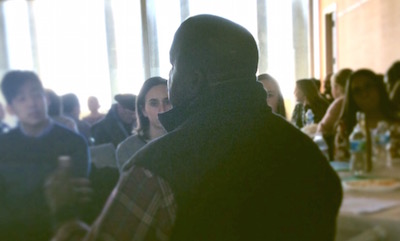Community Discusses ‘Safe Space’ for Opioid Use.

On February 18, more than 100 researchers, activists, nurses, and recovering opioid users wrestled with tough questions at a forum titled “Public Health in Action: A Safe Space for Opioid Users?”
As heroin and other opioid addiction continues to rise—along with the death toll from overdoses—the Boston Health Care for the Homeless Program (BHCHP) has proposed a “safe space” where people can ride out an opioid high indoors, out of danger, and under medical supervision.
Participants in the forum included members of the Medical Campus community, staff from the BHCHP, the Boston Public Health Commission’s Addicts Health Opportunity Prevention Education (AHOPE) program, and individuals in recovery from opioid addiction.
Panelist Edward Bernstein, professor of emergency medicine at the School of Medicine and co-director of the School of Public Health’s BNI ART Institute, drew parallels with the resistance needle exchange programs have faced. “We are at an historic moment,” he said.
Other panelists disagreed. “It may be one of the highest forms of enabling,” said Brianne Fitzergerald (’93), a psychiatric nurse practitioner and educator working primarily with addiction.
Ronald Hill, an advocate and 30-year member of Narcotics Anonymous, called the Safe Space program “a Band-Aid.”
“Why don’t you create more treatment programs?” he asked.
Sarah Mackin (’15), director of AHOPE, agreed more treatment infrastructure is needed—but that the dire state of the system is precisely why Safe Space is necessary.
“The process is broken,” said Mackin. The proposed safe space would be linked to treatment for people who are ready to take that step—but in the meantime, she said, opioid users need to be protected from falling through the gaps and being lost to overdose.
Alexander Walley, assistant professor at MED, agreed. “If you keep people alive long enough,” he said, “they have a chance to get better.”
According to a poll at the outset of the event, more than 90 percent of attendees indicated they were in favor of the Safe Space program. After an exploration of the complex ramifications of such an intervention—both for opioid users themselves, and the community surrounding the proposed site—most still supported the program, but many who had been in support were no longer sure of that stance.
Anne Fidler, assistant dean for public health practice, and the event’s moderator, acknowledged the question was a challenging one.
“Everyone’s goal here is to find solutions to a difficult problem,” she said. “We may have different ideas of how to do it, but we are alike in that.”
The other panelists were: Joanne Guarino, who draws from her own experience with addiction and homelessness as a member of the BHCHP board of directors; and Casey León, research manager at BHCHP.
Public Health in Action is an annual event organized by the Practice Office. The forum was also part of the Spotlight on Mental Health series.